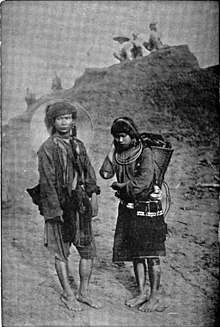Kachin people
The peoples of Kachin (Jingpo: Ga Hkyeng red soil; Burmese: ကချင်လူမျိုး; MLCTS: ka. hkyang lu myui:, pronounced [kətɕɪ̀ɰ̃ lù mjó]), more precisely known as Jingpho Wunpong (Jingpho: Jinghpaw Wunpawng the Confederation of Jingpo) or simply Wunpong (the Confederation), are a confederation of ethnic groups who inhabit the Kachin Hills in northern Myanmar's Kachin State and neighbouring Yunnan Province, China, and Arunachal Pradesh, Assam in Northeastern India. About one million Kachin peoples live in the region. The term Kachin people is often used interchangeably with the main subset, called the Jingpo people in China.
The Jingpho language common to many of the Kachin has a variety of dialects and is written with a Latin-based script created in the late nineteenth century. A Burmese script version was subsequently developed. The Singhpo dialect is spoken in Northeast India and Jingpho in Southwest China.[1]

Kachin is an ethnicity that comprises various linguistic groups with overlapping territories and integrated social structures. Contemporary usage of Kachin relates to a grouping of six ethnicities: Rawang, the Lisu, the Jingpo, the Zaiwa, the Lashi/Lachik and the Lawngwaw/Maru.[2][3] Some definitions distinguish Kachin and Shan (Tai) peoples though some Kachin people have demonstrated the over-simplicity of the concept of lineage-based ethnic identity by culturally "becoming Shans".[4]
There are many theories of how Kachin people got their name. One of them comes from American baptist missionary Dr. Eugenio Kincaid. When he arrived to the northern part of Myanmar, firstly he met with the Gahkyeng people. When he asked them who they were, they replied that they were the villagers from Gahkyeng. Therefore, he wrote "Ga hkyeng" in his notes. European writers called the Kachins "Kakhyens" until 1899. The book "The Great Queen is Coming 1890" described Major Ecy Brong was the first person who started using "Kachin" in Roman script.[5]
Categorisation
In Yunnan, a different categorization is applied and peoples grouped as Wunpong are grouped into four nations. The Chinese definition of Jingpo (which include all speakers of Zaiwa cluster of Northern Burmish languages) is broader than that in Kachin Hills and is somewhat comparable to Wunpong in Kachin Hills.[6] Lisu, Anung (Rawang) and Derung (Taron) peoples in Yunnan are not subordinated to ethnic Jingpo thus are classified outside the Jingpo nation:
- Jingpo nation[6] (Jingpo: Jinghpaw Pawngyawng)
- Lisu nation
- Nu nation[9]
- Derung nation
Culture and traditions
The Kachin people are traditionally known for their disciplined fighting skills, complex clan inter-relations, craftsmanship, herbal healing and jungle survival skills. In recent decades, animist and Buddhist beliefs have been supplanted in some areas by Christianity. According to one source, approximately two-thirds of the Kachin people identify themselves as Christians.[10] Many religious rituals and symbols, such as the annual Manau festival in Myitkyina, are celebrated as folkloric traditions.[11][12]
Religions and practices
Christianity grew from 40% in 1966 to 90~95% in 2010.[13]
References
- Jingpho - Ethnologue.com (limited access - may require subscription) Retrieved 15 April 2017
- Sadan, M. 2007, TRANSLATING GUMLAU:HISTORY, THE ‘KACHIN’ AND EDMUND LEACH. in Sadan, M and Robinne, F. (eds) 2007. Social Dynamics in the Highlands of Southeast Asia, Reconsidering Political Systems of Highland Burma by E. R. Leach. Brill. Leiden, Boston.
- Kachin National Museum, Myitkyina
- Leach, E. R. (1965) Political Systems of Highland Burma: a study of Kachin social structure. Boston: Beacon Press.
- Htoi Ya Tsa Ji, Mungkan hta grin nga ai Jinghpaw mabyin (4) hte Kachin Mabyin (4) hpe chye na ai lam, The Kachin Times, Volume 2,2017
- The Jingpo people is divided into 5 subgroups: Jingpo, Zaiwa, Leqi, Lang'e (Langsu) and Bola.
- 景颇族高日支系考释
- Jingpo - Orientation
- The Rouruo people form a sub-division of the Nu ethnic minority, which also has the sub-division of Anong people.
- "Kachin". Joshua Project. Retrieved 2019-07-12.CS1 maint: ref=harv (link)
- Manao Festival "to propitiate local nat (spirit)" Retrieved 15 April 2017
- Manao Festival description Retrieved 15 April 2017
- Mang, Pum Za (July 2016). "Buddhist Nationalism and Burmese Christianity". Studies in World Christianity. 22 (2): 148–167. doi:10.3366/swc.2016.0147.
Further reading
- Sadan, Mandy (2013). Being and Becoming Kachin: Histories Beyond the State in the Borderworlds of Burma. Oxford University Press and the British Academy.